10Dec2020
On 17-19 November, we and Strategyzer organized a virtual masterclass with Alex Osterwalder. It was an intensive learning experience focusing on innovation and design processes, innovation management, and innovation culture.
Even though it’s impossible to squeeze 12 hours of insights into a written summary, we tried. Here, we compiled the key points of the course and also made three short learning quizzes to make things a bit more fun. We hope you find this helpful. Enjoy!
DAY 1: The Tools of Innovation
On the first day of the masterclass, Osterwalder focused on the topics of managing innovation and portfolios, business model design, and value proposition design. He provided a thorough introduction to the topic of innovation and business model design, and also made us familiar with multiple useful tools.
What Is an Invincible Company?
Osterwalder kicked off by explaining what an invincible company is. “No company can be invincible, but what you can do, is to do everything to stay ahead of the competition”, he actually admitted. There are three characteristics that can make an organization get close to being invincible. Invincible companies:
- constantly reinvent themselves
- compete on superior business models
- transcend industry boundaries
These companies could also be called resilient. “What we’ve seen is that companies that came to this big disruption by COVID-19 with the ability to do all of the three things, they’re more resilient.”
How to Manage Innovation?
Osterwalder highlighted that the challenge in managing innovation is that the things companies need to do in order to manage the current operations differ from managing innovation. In order to be truly innovative, a company needs to exploit the current business and explore new opportunities – both at the same time.
You need to understand that there’s high uncertainty when you explore, and low uncertainty when you exploit.
The innovation process can be very chaotic from the point when you get the idea to the point where you actually execute. However, Osterwalder mentioned that there are many ways you can orchestrate it. He introduced us to different tools that can help manage innovation and coordinate the innovation processes. For example, during the first day, he presented the business model canvas, value proposition canvas, and multiple testing tools.
3 Types of Innovation
“Innovation is not about technology. It’s not about R&D. It’s about value creation”, said Osterwalder. When talking about innovation and especially when innovating, you need to be specific about what type of innovation is in question. According to Osterwalder, there are three different types of innovation:
- Efficiency innovation – improving existing processes and business models, and refining the value proposition.
- Sustaining innovation – replacing and extending value propositions, new channels, and new geographies.
- Transformative innovation – new business models, new value propositions, and entirely new growth engines.
Hardest by far is to actually do transformative innovation. However, Osterwalder pointed out that the transformative innovation doesn’t have to cannibalize your current business – it can also be built on top of that.
Osterwalder also emphasized that even though efficiency innovation is very beneficial, it’s often not enough. If you are only focusing on efficiency and sustaining innovation (like many companies are), you should think about how to do transformative innovation.
Exercise: Write down all the innovation your company is doing and has done for the past three years and define in which type of innovation it belongs to. This way you see in which type of innovation your company is focusing on, and where you still might have room for improvement.
The Basics of Innovation Process
As said, the innovation process is messy. The idea is the easy and free part, whereas the difficulty is to adapt the ideas to the point where they create value for customers and make sense as a business model. Strategyzer has divided the innovation process into three parts:
- Inside – mapping out the idea (duration: 2-3 days).
- Outside – continuous testing and iterations with weekly check-ins (duration: 8-24 weeks).
- Stop / Continue – with supportive evidence you decide whether to stop or continue (duration: 1-2 days).
Osterwalder underlined that great innovative companies have multiple innovation processes going on simultaneously. And it’s actually necessary to work on numerous projects at the same time, in order to find even one that succeeds.
Business Model Design
To help you design business models, Osterwalder presented his Business Model Canvas tool. This is the tool you can use to map your existing business, but also your new business idea or innovation. As Osterwalder put it, you are a pro, when you can simply tell your entire business model story by using the business model canvas.
The nine sections of the business model canvas are:
- Value proposition = What is the value you bring to your customers?
- Customer segments = Who are your customers?
- Channels = How do you reach your customers?
- Relationships = What type of relationships you establish with your customers?
- Revenue streams = How do you make money?
- Key activities = Which are the critical activities we need to do in order to serve our customers?
- Key resources = Which resources and assets we need in order to serve our customers?
- Key partners = Which partners we work with?
- Cost structure = What are the costs of our business?
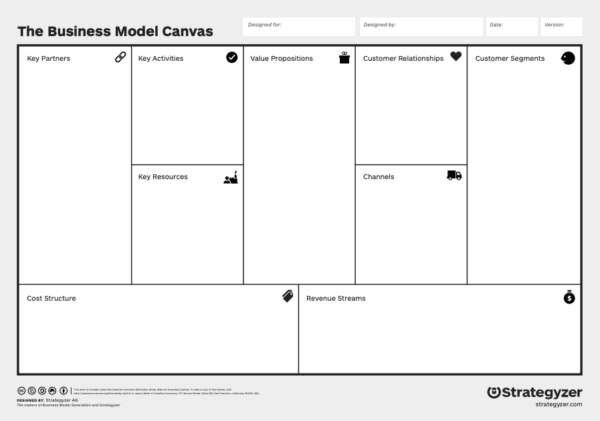
A few practical tips from Osterwalder for using the Business Model Canvas:
- Don’t put too many details as they hide the bigger picture. Put only what is relevant to telling the big picture strategic story.
- Combine visuals and words for a quicker understanding of your business model.
- Use colour coding to relate certain building blocks in order to make it easier to understand and explain your business model and strategy.
- Do not create orphan elements. Every building block should be connected to another.
Value Proposition Design
To make it easier for you to design value propositions, Osterwalder introduced the Value Proposition Canvas. This is the tool that helps you map products and services, and to tell the story of how you create and deliver value for your customers.
The sections of the Value Proposition Canvas are:
The customer profile (the circle)
- Jobs-To-Be-Done = What is the customer trying to do and achieve?
- Pains = What are the pains that are holding them back?
- Gains = What are the positive outcomes they are looking for?
The value map (the square)
- Products and services = What are our products and services?
- Pain relievers = How do our products and services relieve the pains of the customers?
- Gain creators = How do our products help our customers succeed?
So, it’s a visual tool to help you make explicit what you are already doing, and it also makes innovation easier.
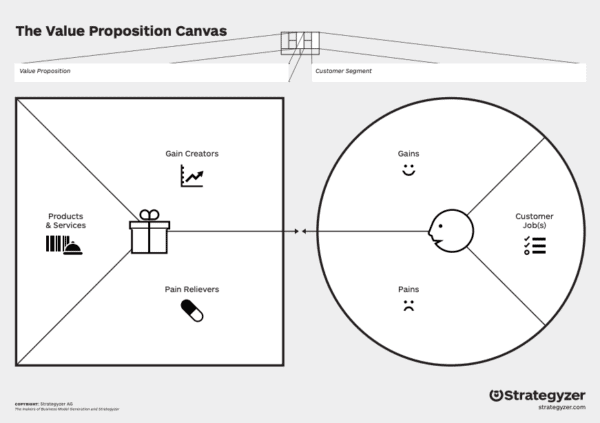
A few practical tips from Osterwalder for using the Value Proposition Canvas:
- Remember that the customer profile is about understanding your customer; you don’t design them. The value map part is about designing: you choose which or the customers’ pains and gains you want to address.
- The gains are not always opposite to the pains. Sometimes the opposite of a pain is an expectation of the customer that you just have to meet.
- It’s important to do this continuously as your customers’ pains and gains change over time.
Portfolio Management
When looking at portfolio management, Osterwalder and his colleague Yves Pigneur noticed that it would make sense to also have a tool to visualize and analyze a collection of business models. That is where the portfolio map – their latest tool – came in. The portfolio map combines both the exploit and explore areas that Osterwalder talked about. As he emphasized throughout day 1, every company should do both at the same time: manage existing businesses (exploit) and innovate on new business opportunities (explore).
The exploit part on the portfolio map tool helps you manage what you have by looking at the return on the one hand and at the death and disruption risk on the other. There, you scale emerging business models, renovate declining ones, or make successful ones more resilient. You manage the existing businesses by acquiring, merging, partnering, or investing in other business ideas, or you simply improve your own businesses. You can also divest or dismantle declining businesses.
On the explore part, your search for new growth engines requires two main activities: increase the expected return by designing better business models and reduce the innovation risk through rigorous testing. You manage the explore portfolio by ideating and testing your own innovations, or invest in outside ventures – or you can do both.
The crucial issue in innovation according to Osterwalder is that you can’t pick the winner idea yourself; you need to invest in testing and evidence, and only then can you see which projects have potential. “The only task of an innovator is to reduce the risk and uncertainty of an idea.”
Osterwalder also presented some interesting figures for us regarding successful innovations. According to research, 6 out of 10 projects lose money, 3 out of 10 make some money, and only 4 out of 1000 are home runs. What that means for an SME is that if you invest in 10 projects, only one will succeed.
“Avoid big failure, or you’re dead. Embrace small failures, or you’re dead”, Osterwalder concluded.
DAY 2: Designing Competitiveness
On the second day of the masterclass, Osterwalder took us deeper into the world of designing and competing on business models. He mentioned that still most companies are focusing on product and technology innovation, and while that is also important, there’s huge potential in innovating on business models. Thus, during day 2, we discussed competing on business models, designing and prototyping, and shifting from old to new business models. “It’s design first, and decision second”, Osterwalder emphasized.
Competing on Business Models
Osterwalder started by talking about Business Model Patterns; the repeatable configurations of different business model building blocks that help to strengthen an organization’s overall business model. If you can find these patterns, you are able to copy them. “You are able to take business models from completely different industries and import them into your industry”, said Osterwalder.
He went on to explain that there are actually two types of pattern libraries: exploration patterns and exploitation patterns. The exploration patterns are invent patterns – in other words completely new business model patterns. The exploitation patterns are shift patterns which you can use when you move or change from an existing business model to a better performing one.
Invent Patterns
The invent pattern library consists of three sections: frontstage disruption, backstage disruption, and profit formula disruption. In each section, Osterwalder introduced three different patterns with real life company cases. In addition, he shared a trigger question and an assessment question to help you apply these patterns to your new business ideas and existing business models.
Invent patterns – Frontstage disruption
Market explorers – the companies that develop innovative value propositions that create or unlock completely new, untapped or underserved markets. (Examples: Nintendo Wii, Tesla, Sears)
- Trigger question: How could we tap into new, untapped or underserved markets with large potential?
- Assessment question: How large and attractive is the untapped market potential we are going after?
Gravity creators – the companies that add “switching costs” that make it difficult for customers to leave or switch to competitors. (Examples: Xbox, Microsoft Windows, iPod)
- Trigger question: How could we make it difficult for customers to leave and increase switching costs in a positive way?
- Assessment question: How easy or difficult is it for our customers to leave or switch to another company?
Channel kings – the companies that radically change how to reach and acquire a large number of customers. (Examples: Dollar Shave Club, Tupperware, Nespresso)
- Trigger question: How could we increase market access and build strong and direct channels to our end customers?
- Assessment question: Do we have large-scale, and ideally, direct access to our end customer?
Invent patterns – Backstage disruption
Resource castles – the companies that create a competitive advantage with key resources that are difficult or impossible for competitors to copy. (Examples: Uber, Dyson, Waze)
- Trigger question: How could we make difficult-to-copy resources a key pillar of our business model?
- Assessment question: Do we own key resources that are difficult or impossible to copy and which give us a significant competitive advantage?
Activity differentiators – the companies that radically change which activities they perform and how they combine them to create and deliver value to customers. (Examples: Zara, Dell, Patagonia)
- Trigger question: How could we create more value for customers by configuring activities in innovative ways?
- Assessment question: Do we create significant value for customers because we perform activities in disruptively innovative ways?
Scalers – the companies that find radically new ways to scale where others stayed stuck in conventional non-scalable business models. (Examples: McDonald’s, Ikea)
- Trigger question: What could we do differently to make our business model more scalable (eg. eliminate resource and activity bottlenecks)?
- Assessment question: How rapidly and how easily can we grow our business model without substantial additional resources and activities?
Invent Patterns – Profit Formula Disruption
Revenue differentiators – the companies that find innovative ways to capture and monetize value, unlock previously unprofitable markets and/or substantially increase revenue. (Examples: Fortnite, Spotify, Xerox, Salesforce)
- Trigger question: Which new revenue streams could we introduce to capture more value from our customers or unlock unprofitable markets?
- Assessment question: Do we use strong revenue streams and pricing mechanisms to monetize value creation for customers?
Cost differentiators – the companies that build a business model with a game-changing cost structure, not just by streamlining activities and resources but by doing things in disruptive new ways. (Examples: EasyJet, Airbnb, Skype)
- Trigger question: Could we change our costs structure significantly by creating and delivering value with different and differently configured resources and activities?
- Assessment question: Is our cost structure conventional or disruptive?
Margin masters – the companies that achieve significantly higher margins than competitors by focusing on what customers are willing to pay for most while keeping cost structures in check. (Examples: iPhone, Nintendo Wii)
- Trigger question: Could we change our cost structure significantly by creating and delivering value with different and differently configured resources and activities?
- Assessment question: Is our cost structure conventional or disruptive?
Design Thinking & Prototyping
Osterwalder explained that inventing new business models requires a design mindset. In the Strategyzer designing process, there are 4 steps: ideate, prototype, assess, and decide. As he said during the first day, the ideation is often the easy part, but after it can get tricky.
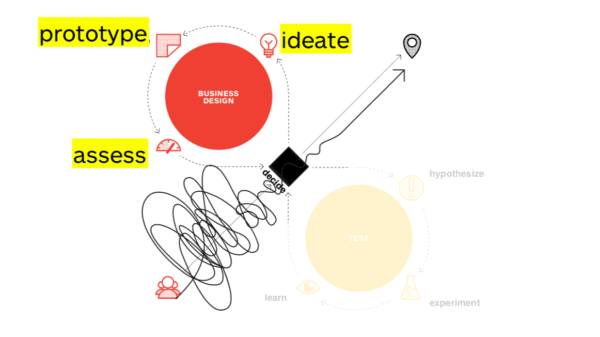
Prototyping is not about refining your initial idea, it’s actually about exploring alternatives. “You don’t know what’s going to work, so if you make 5 prototypes, you’re better off than if you do just one”, Osterwalder elaborated.
When prototyping there are actually multiple things you can do; CADs, sketches, plans, mock-ups, etc. Whatever you do, Osterwalder highlighted that the key idea in prototyping is to be quick. You don’t want to refine the idea and spend too much time on it so that you can actually drop it if necessary. “Don’t fall in love with your first idea”, he underlined.
Once you’ve made the prototypes, you need to assess. What helps you to do this, is the 9 assessment questions that Osterwalder introduced us to. After going through those questions, it is easier for you to decide which projects you continue working with.
Exercise: Carefully go through the 9 assessment questions to evaluate your existing business model.
Shifting from Old to New Business Models
“Business models expire like yogurt in your fridge…So the question is: how do we reinvent ourselves before a crisis?”
Osterwalder explained that now, it is more important than ever for companies to be able to pivot to new business models. However, he highlighted that sometimes it’s not enough if you shift to a new business model; sometimes you need to also kill your existing business model.
To help you in changing your old business model to a new one, Osterwalder has come up with shift patterns. “This is all about taking an existing business model and improving it.” Just like with the invent patterns, Osterwalder has created a library of shift patterns as well.
Value Proposition Shifts are radical shifts of the value created for customers. The types of shift patterns in this section are:
- From Product to Service (e.g. Hilti)
- From Low Tech to High Tech
- From Sales to Platform (e.g. iPhone)
Frontstage Driven Shifts are radical shifts of who is targeted and how products and services are delivered. The types of shift patterns in these sections are:
- From Niche to Mass Market (e.g. TED)
- From B2B to B2(B2)C
- From Low to High Touch
Backstage Driven Shifts are radical shifts of how value is created. The types of shift patterns in these sections are:
- From Dedicated to Multi-Usage (e.g. Fujifilm, Laurastar)
- From Asset Heavy to Asset Light
- From Closed to Open (Innovation)
Profit Formula Drive Shifts are radical changes in how profits are made in terms of revenues and costs. The types of shift patterns in these sections are:
- From High Cost to Low Cost (e.g. Dow Xiameter)
- From Transactional to recurring revenue
- From Conventional to Contrarian
To help you to use these patterns and think about how you could shift, Osterwalder again provided questions for leaders. He also underlined that you should always think of each pattern in both ways. For example, it’s not that you should always think of shifting from product to service, it could be that in your case it makes more sense to move from service to product. He also emphasized that you shouldn’t look for inspiration from your competitors, but instead focus on your specific situation. It’s good to remember that there is no single best one, and not all of them can necessarily be applied to your business. “The question is what’s the right business model for you in your situation.”
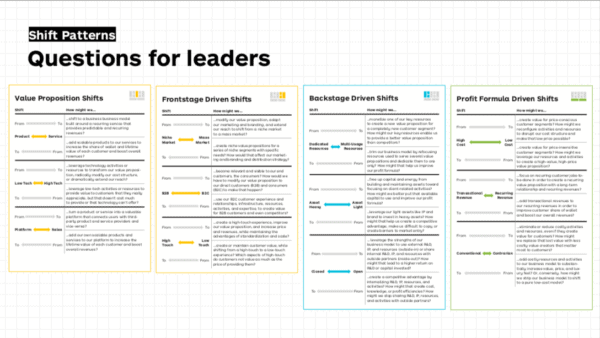
Lastly, Osterwalder spoke about Multiple Shift Patterns, referring to the possibility of shifting from your existing business model to actually using multiple shift patterns at the same time. He used the example of Ørsted, who shifted from oil, gas, and coal business to green energy. “It’s not about applying one shift or one pattern. It’s about combining them to make the best out of a particular situation”, he concluded.
“Don’t just think about a smaller version of what you want to build – come up with variety. Throw that mental model away and come up with diverse alternatives, so that you can over time use the best one.”
DAY 3: Reducing Risk and Uncertainty + Test Mindset
During the last day of the masterclass Osterwalder mostly focused on testing. But at the end of the day, he also shared some ideas related to innovation management and innovation culture.
He kicked off by asking: Why do businesses fail? According to research, 42% of the new business ventures fail because there’s no market need. In addition, 7 out of 10 new products and services don’t deliver as expected. “It’s not because people are not smart. It’s because there are no processes to kill ideas that shouldn’t be alive anymore.”
Osterwalder even gave us the good example of Quibi that raced 1,75 billion USD, had an excellent management team, but had to kill the startup within 6 months, because there just was no demand for the product. So, it’s very dangerous to make one big bet and hope for big returns. “What you really need to do is to make many small bets, and you kill those that are not working out, so the great ideas emerge. You can’t pick the winner.”
Testing Business Ideas
Osterwalder emphasized that the design process he explained on day 2 is actually just half of the story. You should never only stay in that process but actually continue from the design phase to the testing phase.
In the testing process, you should go through 4 steps: hypothesize, experiment, learn, and then decide. The testing process is all about getting evidence to help you figure out which ideas are worth going forward with, and which ones you should kill. And the truly important thing is that this is a continuous process. “You should go through this loop all the time.”
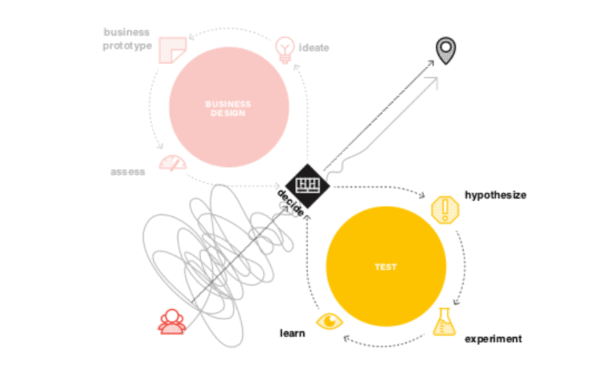
How Do You Hypothesize?
Often people skip or underestimate the hypothesize step, Osterwalder mentioned. They just immediately try to go and build something that they think is going to work. But you first need to hypothesize and ask: “What needs to be true for this idea to work?”
The hypotheses can come from your value proposition, your business model, and/or your business environment. Osterwalder said that you should always formulate your hypotheses to start with “We believe that…”.
When making hypotheses, you need to think of:
- Desirability – do people want it?
- Feasibility – can I build it?
- Viability – can I make money from it?
You also need to remember that you can’t test everything. First, you need to extract hypotheses, and then prioritize them. Pick only the ones that you need to test in order to see if your idea really can work. For example, usually, the feasibility related hypothesis is not so important, because you should first focus on desirability.
How Do You Experiment?
After you have extracted and prioritized the hypotheses, you can move on to the experiment phase. Here, you need to figure out, which experiments are best suited for your hypotheses. With the help of those experiments, you then get evidence that you can use to move on to the third phase.
In the experiment phase, you first need to design the experiments and then run the experiments. To help you with experimentation, Osterwalder provided an entire library of experiments. When selecting which type of experiment you will run, you should look at a) the strength of the evidence that you will get from it, b) the time it takes to go through with it, and c) the costs that it takes to run it.
One of the most important things to remember here is that you need to somehow try to get strong evidence. “You should go beyond customer interviews and surveys. That’s very weak evidence, and it’s only something you can start with.” Remember, what people say and what people do, are two different things. In addition, you should experiment with enough customers in order to get stronger evidence.
It is important to note that the goal is not to simply run experiments but to make innovation progress. You need to use experiments as a tool to find answers to key innovation questions and reduce the uncertainty around that new idea. “Your job is to reduce the risk”, Osterwalder emphasized.
Osterwalder’s rules of thumb to help you pick the right experiment:
- Go cheap and fast early on in your journey.
- Increase the strength of evidence with multiple experiments for the same hypothesis.
- Always pick the experiment that produces the strongest evidence given your constraints.
- Reduce uncertainty as much as you can before you build anything.
How Do You Learn and Decide?
After running the experiments, you move on to the learn and decide phase. “I really put emphasis on the decision. Learning is never the goal.”
Here you take a close look at the insights you get from the experiments and see whether they support and validate your hypothesis. The experiments you run can support your hypothesis, or not support your hypothesis, and they can provide you new insights and/or unclear insights. “It’s important that you don’t get overconfident if the evidence is weak”, Osterwalder highlighted.
Once you have figured out how the evidence supports your hypothesis, you decide what to do with the idea. And when deciding, it’s good to keep in mind that you should not “fall in love with the first idea”.
Managing Innovation Portfolios
When talking about managing innovation, Osterwalder started by elaborating on innovation metrics. “Today, we can measure the risk and uncertainty – we have the metrics to do so.”
To make measuring simpler, Osterwalder suggested we use a tool called Project Scorecard. It’s a tool that can help you assess the progress that your innovation teams are making in their quest to find business models that work. With the tool you simply score the strategic fit, the desirability, feasibility, viability, and adaptability of the project.
Keep in mind that the focus should not just be on products and services when running experiments to test new business ideas. Our focus should be on assessing if we are making progress from our initial idea to a profitable business.
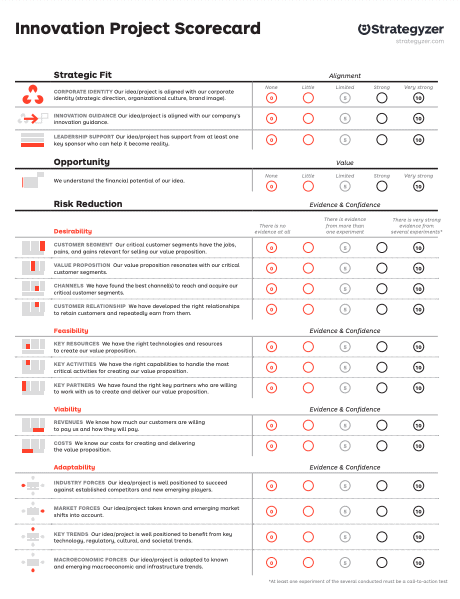
One important issue related to metrics is that as a leader you need to ask your team whether they have the data – the evidence. “We often catch teams not presenting the data, even though they have it.” So before making any decision make sure you are aware of all the evidence.
Osterwalder also highlighted that leaders should be aware of the innovation myths that many consider true. Some leaders still believe the challenge in innovation is to…
- find the right idea
- execute the plan
- monitor the results
- avoid failure
- predict the future based on the past.
And as you probably remember, Osterwalder highlighted that these are not really valid.
Managing Innovation Culture
Further on, Osterwalder spoke about managing an innovation culture. The key thing is to cultivate both explore and exploit under one roof. According to Osterwalder, the exploitation culture cherishes the management, systematic improvement, and growth of existing business. Whereas, the exploration culture cultivates the creation, discovery, validation, and acceleration of new ideas that are foreign to an organization.
To do this, Osterwalder provided one more tool: the culture map. The culture map consists of three questions:
- Outcome – What are our desired outcomes?
- Behaviour – What behaviors will allow us to achieve our desired outcomes?
- Enablers/Blockers – What enables and blocks us from our goals?
You need to remember that designing a culture is different. “You can’t design culture like designing a car. You need to design it like a garden.” What leaders can and should do is to focus on affecting the last section, the enablers, and blockers. Those are the policies, processes, reward systems, and rituals that can either enable an innovation culture or kill an innovation culture.
The enablers can be for example strategic guidance, resource allocation, reward system, and especially legitimacy and power. The blockers on the other hand are often lack of time, lack of innovation strategy, short-term focus of leadership, bureaucracy, fear of failure, linear processes, etc. Osterwalder suggested that first, you should “focus on killing the blockers”. So, what blocks the development of your innovation culture today?
Thank you to everyone who participated in our very first virtual masterclass!
We hope you received valuable ideas, insights, and tools to take your organization to the next level in terms of innovation. And we wish you the best of luck with executing all the ideas you received!

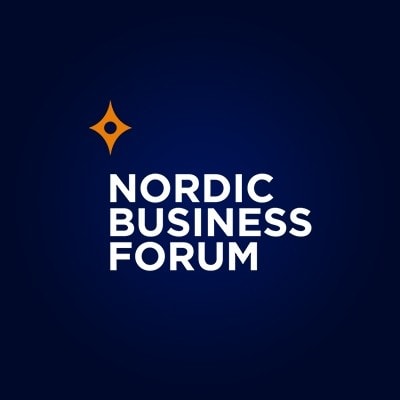 by:
by: 
